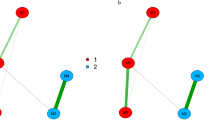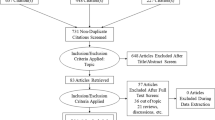Abstract
Background
This study aims at providing qualitative and quantitative evidence on the relevance of two broadly used mental health self-report measures—Impact of Event Scale Revised (IES-R) and Hopkins Symptom Checklist 37 for Adolescents (HSCL-37A)—for use in Eastern Democratic of Congo, as no psychological assessment instruments were available for this region. We therefore describe an apt procedure to adapt and translate standard screening instruments in close collaboration with the local community, feasible under challenging conditions in emergency settings.
Method
Focus groups and interviews with community key figures in psychosocial care were employed to ensure local validity of the adaptation and translation process. Consequently, the questionnaires’ internal consistency (Cronbach’s alpha) and construct validity (principal component analysis, testing of theoretical assumptions) were assessed based on a clustered school-based community survey among 1,046 adolescents (13–21 years) involving 13 secondary schools in the Ituri district in Eastern Democratic Republic of Congo.
Results
Key-informant qualitative data confirmed face and construct validity of all IES-R and all HSCL-37A anxiety items. Additional culture-specific symptoms of adolescent mental ill-health were added to enhance local relevance of the HSCL-37A depression and externalizing subscales. Quantitative analysis of the survey data revealed adequate internal consistency and construct validity of both adapted measures, yet weaker results for the externalizing scale. Furthermore, it confirmed the internalizing/externalizing factor structure of the HSCL-37A and the theoretically deviating intrusion/arousal versus active avoidance factor structure for the IES-R.
Conclusions
Community-based adaptation can extend the validity and local relevance of mental health screening in emergency and low-income settings. The availability of adequate Swahili and Congolese French adaptations of the IES-R and HSCL-37A could stimulate the assessment of psychosocial needs in war-exposed Eastern Congolese adolescents.
Similar content being viewed by others
References
Almedon A, Summerfield D (2004) Mental well-being in settings of complex emergency: an overview. J Biosoc Sci 36:381–388
Balaban V (2006) Psychological assessment of children in disasters and emergencies. Disasters 30:178–198
Barenbaum J, Ruchkin V, Schwab-Stone M (2004) The psychosocial aspects of children exposed to war: practice and policy initiatives. J Child Psychol Psychiatry 45:41–62
Bass J, Ryder R, Lammers MC, Mukaba T, Bolton P (2008) Post-partum depression in Kinshasa, Democratic Republic of Congo: Validation of a concept using a mixed-methods cross-cultural approach. Trop Med Int Health 13:1534–1542
Bean T, Eurelings-Bontekoe E, Derluyn I, Spinhoven P (2004) Hopkins Symptom Checklist-37 for adolescents (HSCL-37A), User’s Manual. Stichting Centrum ‘45, Oegstgeest
Bean T, Derluyn I, Eurelings-Bontekoe E, Spinhoven P (2006) Validation of the multiple language versions of the reactions of adolescents to traumatic stress questionnaire. J Trauma Stress 19:241–255
Bean T, Eurelings-Bontekoe E, Derluyn I, Spinhoven P (2007) Validation of the multiple language versions of the Hopkins Symptom Checklist-37 for refugee adolescents. Adolescence 42:51–71
Beaton D, Bombardier C, Guillemin F, Ferraz MB (2000) Guidelines for the process of cross-cultural adaptation of self-report measures. Spine 25:3186–3191
Beneduce R, Jourdan L, Raeymaekers T, Vlassenroot K (2006) Violence with a purpose: exploring the functions and meaning of violence in the Democratic Republic of Congo. Intervention 4:32–46
Betancourt P, Bass J, Borisova I, Neugebauer R, Speelman L, Onyango G, Bolton P (2009) Assessing local instrument reliability and validity: a field-based example from northern Uganda. Soc Psychiatry Psychiatr Epidemiol 44:685–692
Bhui K, Mohamud S, Warfa N, Craig T, Stansfeld S (2003) Cultural adaptation of mental health measures: improving the quality of clinical practice and research. B J Psych 183:184–186
Bolton P (2001) Cross-cultural validity and reliability testing of a standard psychiatric assessment instrument without a gold standard. J Nerv Ment Dis 189:238–242
Bolton P, Wilk C, Ndogoni L (2004) Assessment of depression prevalence in rural Uganda using symptom and function criteria. Soc Psychiatry Psychiatr Epidemiol 39:442–447
Bracken P, Giller J, Summerfield D (1995) Psychological responses to war and atrocity: the limitations of current concepts. Soc Sci Med 40:1073–1082
Brunet A, St-Hilaire A, Jehel L, King S (2003) Validation of a French version of the Impact of Event Scale-Revised. Can J Psychiatry 48:56–61
Colins O, Broekaert E, Vandevelde S, Van Hove G (2008) Max Weber and Alfred Schutz—the theoretical and methodological background of the case-oriented quantification approach behind winMAX. Soc Sci Comp Rev 26:369–378
Creamer M, Bell R, Failla S (2003) Psychometric properties of the Impact of Event Scale-Revised. Behav Res Ther 41:1489–1596
Derluyn I, Broekaert E, Schuyten G, De Temmerman E (2004) Post-traumatic stress in former Ugandan child soldiers. Lancet 363:861–863
Derogatis L, Lipman R, Rikels K, Ulenhoth E, Colvi L (1974) The Hopkins Symptom Checklist (HSCL): a self-report symptom inventory. Behav Sci 19:1–15
Devries H (1995) Socioeconomic differences in smoking—Dutch adolescents beliefs and behaviour. Soc Sci Med 41:419–424
Guillemin F (1995) Cross-cultural adaptation and validation of health-status measures. Scand J Rheumatol 24:61–63
Hollifield M, Warner T, Lian N, Krakow B, Jenkins J, Kesler J, Stevenson J, Westmeyer J (2002) Measuring trauma and health status in refugees. A critical review. JAMA 288:611–621
Israel B, Schultz A, Parker E, Becker A (1998) Review of community-based research: assessing partnership approaches to improve public health. Annu Rev Public Health 19:173–202
Jones L, Kafetsios K (2002) Assessing adolescent mental health in war-affected societies: the significance of symptoms. Child Abuse Negl 26:1059–1080
Kienzler H (2008) Debating war-trauma and post-traumatic stress disorder (PTSD) in an interdisciplinary arena. Soc Sci Med 67:218–227
Mels C, Derluyn I, Broekaert E, Rosseel Y (2009) Screening for traumatic exposure and post-traumatic stress symptoms adolescents in war-affected Eastern Democratic Republic of Congo. Arch Pediatr Adolesc Med 163:525–530
Mercer S, Ager A, Ruwanpura E (2005) Psychosocial distress of Tibetans in exile: integrating Western interventions with traditional beliefs and practice. Soc Sci Med 60:179–189
Olde E, Kleber R, van der Hart O, Pop V (2006) Childbirth and posttraumatic stress responses, a validation study of the Dutch Impact of Event Scale-Revised. Eur J Psychol Assess 22:259–267
Patel V (2001) Cultural factors and international epidemiology. Br Med Bull 57:33–45
Patel V, Flisher A, Nikapota A, Malhotra S (2008) Promoting child and adolescents mental health in low and middle income countries. J Child Psychol Psychiatry 49:313–334
Rasmussen A, Smith H, Keller A (2007) Factor structure of PTSD symptoms among West and Central African Refugees. J Trauma Stress 20:271–280
Silove D, Ekblad S, Mollica R (2000) The rights of the severely mentally ill in post-conflict societies. Lancet 355:1548–1549
Sim J (1998) Collecting and analysing qualitative data: issues raised by the focus group. J Adv Nurs 28:345–352
Summerfield D (1999) A critique of seven assumptions behind psychological trauma programmes in war-affected areas. Soc Sci Med 48:1449–1462
Sznitman S (2007) An examination of the normalisation of cannabis use among 9th grade school students in Sweden and Switzerland. Addict Res Theory 15:601–616
Toole M (2002) Improving psychosocial survival in complex emergencies. Lancet 360:869
Van Ommeren M (2003) Validity issues in transcultural epidemiology. Br J Psychiatry 182:376–378
Van Windenfelt BM, Treffers P, de Beurs E, Siebelink BM, Koudijs E (2005) Translation and cross-cultural adaptation of assessment instruments used in psychological research with children and families. Clin Child Fam Psychol Rev 8:135–147
Ventevogel P (2007) Properties of the Hopkins Symptom Checklist (HSCL-25) and the Self-Reporting Questionnaire (SRQ-20) as screening instruments used in primary care in Afghanistan. Soc Psychiatry Psychiatr Epidemiol 42:328–335
Weiss D (2004) The Impact of Event Scale-Revised. In: Wilson J, Keane T (eds) Assessing psychological trauma and PTSD, 2nd edn edn. The Guilford Press, London, pp 168–190
Williams R, Alexander D, Bolsover D, Bakke F (2008) Children, resilience and disaster: recent evidence that should influence a model of psychosocial care. Curr Opin Psychiatry 21:338–344
Acknowledgments
We would like to thank MONUC and the coordinators of MEDAIR Bunia for their logistical support, the MEDAIR staff for their cooperation, and all local NGOs, secondary schools and the participating pupils for help making this research possible. This study was supported by a doctoral grant of the Flemish University Council, University Development Cooperation (VLIR-UOS).
Conflicts of interest statement
None.
Author information
Authors and Affiliations
Corresponding author
Rights and permissions
About this article
Cite this article
Mels, C., Derluyn, I., Broekaert, E. et al. Community-based cross-cultural adaptation of mental health measures in emergency settings: validating the IES-R and HSCL-37A in Eastern Democratic Republic of Congo. Soc Psychiat Epidemiol 45, 899–910 (2010). https://doi.org/10.1007/s00127-009-0128-z
Received:
Accepted:
Published:
Issue Date:
DOI: https://doi.org/10.1007/s00127-009-0128-z




